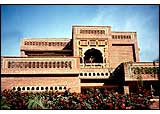 |
Flower
Detail from
Shahdara Garden
|
 |
|
|
|
 |
"In
the time of His Majesty the fort has been built of solid bricks
and lime, and as, from time to time, the seat of government was
established here, lofty palaces were built, to which additional
beauty was given by luxuriant gardens." Ain-i-Akbari, v.
2, p. 317.

The
history of gardens in Lahore is as old as the Islamic history
of the city itself. In particular, the Ghaznavid period sources
of the eleventh century mentioned the fragrance, flowers, and
fresh air of Lahore. Malik Ayaz, a slave of the Ghaznavid ruler
Mahmood and later governor of Lahore, planned a new city near
the existing one in the beginning of the eleventh century. The
precise location of the site is not known. After that, the town
continued to grow in all directions. During the period 1021-1526
AD, or before the coming of the Mughals, we read about six gardens
in the suburbs: Bagh-i Malik Ayaz, Bagh-i Zanjani, Bagh Shah Ismail,
Bagh Qutb-ud Aibak, Bagh-i Shah Kaku Chishti, and Bagh-i Daulat
Abad; these all became extinct subsequent to the urbanization
and urban development of Lahore. The construction and planting
of gardens in and around the city started with the arrival of
the Mughals on the subcontinent in 1526. The earliest Mughal gardens
in Lahore were Bagh-i Mirza Kamran, in the northwest, built by
the son of Babur; and Naulaka Bagh and Bibi HajTaj, both on the
east side. Among the gardens, only the baradari (pavilion)
of Bagh-i Mirza Kamran survives today to any extent.

|
 |
Exterior
Wall of Lahore Fort
|
|
|
|
|
|
The
construction of gardens on a large scale began with the coming of
Emperor Akbar to power, and particularly between 1584-98 when he
made Lahore the capital of his empire. He reconstructed the fort
and fortified the city with a double defensive wall. All important
nobles of the Mughal empire, serving in whatever region, built pleasure
gardens and fruit gardens in all directions, in particular along
major roads connecting Lahore with Delhi in the east, Multan road
in the southeast, and Grand Trunk Road in the west. During Shah
Jahan's time, the areas in between were filled with a variety of
gardens. |
|
|

At Shahdara,
located northwest of the city along the Kabul and Kashmir route,
the Bagh-i Mirza Kamran, Bagh-i Dilkusha (built by Queen Nur Jahan
and where the tomb of Jahangir was later built), the garden quadrangle
of Asaf Khan, Akbari Serai (the present forecourt to the tomb of
Jahangir), and the probable garden around the tomb of Nur Jahan
still survive today in relatively good condition. In all these gardens
the planting has changed considerably. The other gardens which are
mentioned in the sources on either bank of the Ravi River near Shahdara
are Naulakha Bagh, Badami Bagh, Bagh-i Dil Afruz, Bagh-i Andijan,
Bagh-i Nizam ud Din Ahmad, and Bagh-i Mirza Moman Ishaq Baz. The
hinterland on the east along the Grand Trunk Road became a special
focus of attention for the construction of gardens during the Mughal
period.
 |
Contemporary
Garden in
the Suburbs of Lahore
|
 |
|
|
|
Few gardens
existed along this route before Shah Jahan's time, but with the
construction of the canal and Shalamar Garden, the interest in
this area increased. The fragments of some Mughal period gardens
still survive. These include: Gulabi Bagh, Bagh-i Eeshan, Pervaiz
Bagh, Bagh Mahabat Khan, Anguri Bagh, Bagh Fateh Garh, the Bagh
around the tomb of Nadira Begum, Bagh Abul Hasan, Bagh Ali Mardan
Khan, and Bagh Mulla Shah.
|
 |
Contemporary
Garden in
the Suburbs of Lahore
|
 |
|
|
| |
Contemporary
Garden in
the Suburbs of Lahore
|

|
|
|
|

A series of
gardens was also built along the Multan road on the south side
of the city. The most famous among these were Bagh Wazir Khan,
Bagh-i Anarkali, and Chauburji garden or Nawan Kot garden (around
the so-called tomb of Zeb un Nisa). These gardens had a variety
of landscape features. Some were orchards, others were attached
to mansions. Some were walled and had elaborate gateways, walkways,
water features, and elaborate plantations. By the end of Shah
Jahan's rule, Lahore became the "city of gardens." The garden
suburbs extended in every direction for several miles. These gardens
were built for the pursuit of pleasure, the extension of residences,
as fruit orchards, or were built around tombs. A number of them
survived till the middle of the nineteenth century and fulfilled
a variety of functions, such as ceremonial centers, official business,
pleasure gardens, poetry reading, and meditation. They also served
as transit stations during processional journeys. Also with streams
of water, wells, mosques, tombs, and mansions, they dominated
the land-use plan of the city. The tradition of constructing gardens
continues even to this day, and one can find modern gardens spread
throughout every part of the city.
|
|

|
 |
 |
 |
|